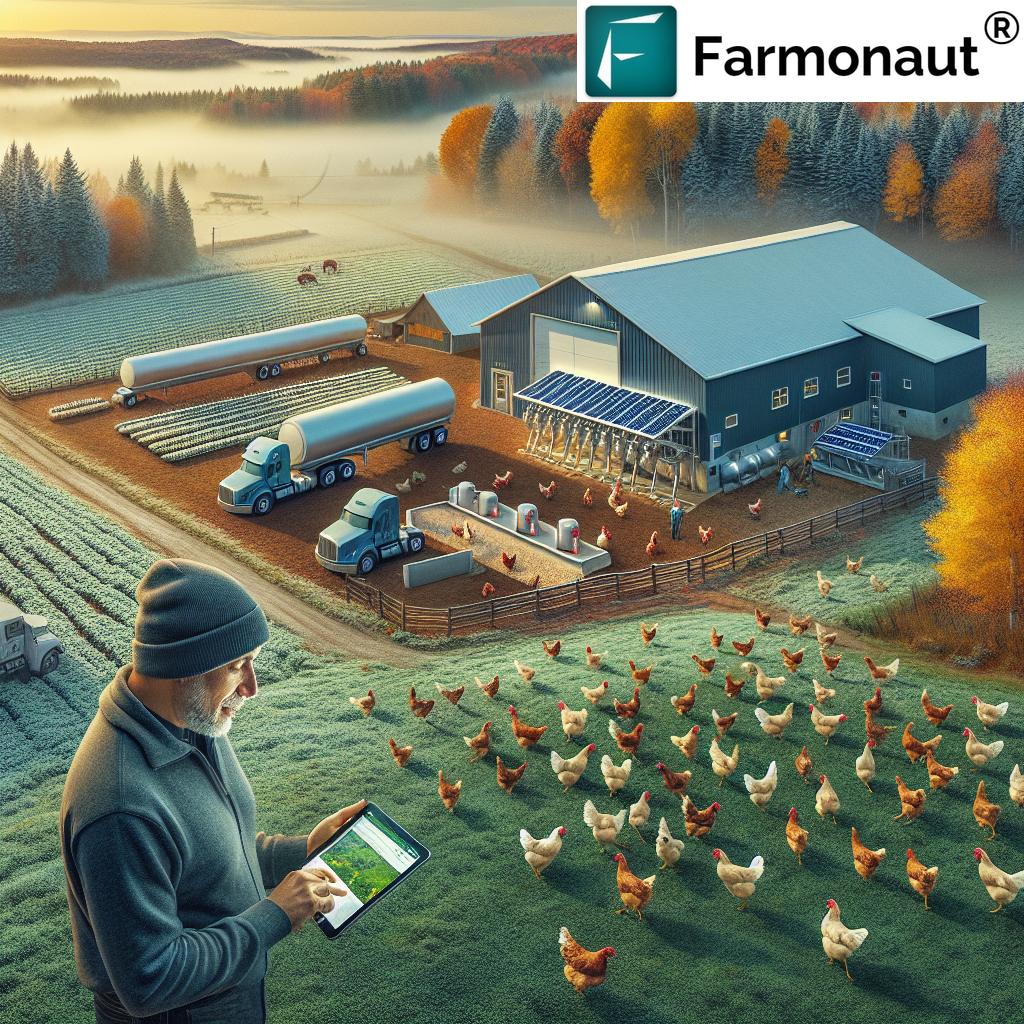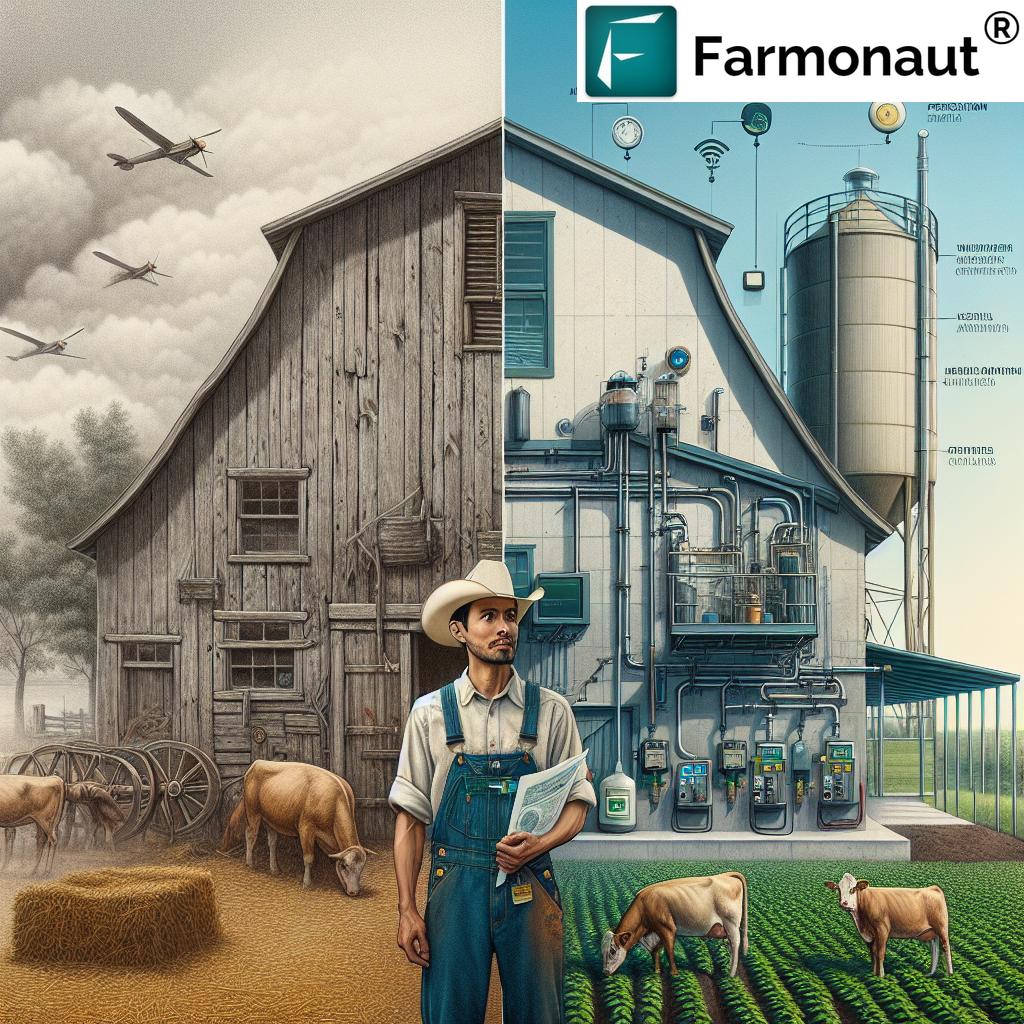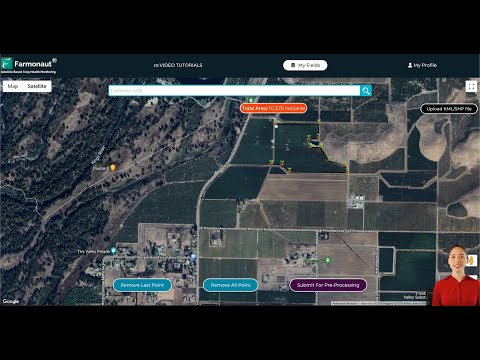Ontario’s Poultry Paradox: Navigating Farm-to-Market Challenges in Northern Agriculture
“Ontario’s northern poultry farmers navigate challenges across three key regions: Kenora, Vermillion Bay, and Dryden.”
As we delve into the complex world of Ontario’s agricultural landscape, particularly focusing on the poultry sector in the northern regions, we find ourselves faced with a paradox. On one hand, there’s a growing demand for locally sourced, fresh produce and poultry products. On the other, small-scale farmers in areas like Kenora, Vermillion Bay, and Dryden are grappling with a myriad of challenges that threaten their very existence. In this comprehensive exploration, we’ll unravel the intricacies of this situation, examining the hurdles faced by farmers and the innovative solutions emerging in the face of adversity.
The Northern Ontario Agricultural Landscape
Northern Ontario’s agricultural sector, particularly its poultry farming, is a testament to the resilience and adaptability of Canadian farmers. Despite the harsh climate and geographical challenges, the region has a rich history of agricultural production. However, as we approach October 2024, the landscape is changing rapidly, both literally and figuratively.
- Climate Challenges: Extreme weather conditions, especially during the cold fall and winter months, pose significant obstacles for farmers.
- Market Access: Limited local markets and difficulties in accessing larger urban centers complicate the farm-to-market process.
- Regulatory Hurdles: Complex and often restrictive policies at both the provincial and federal levels create additional barriers for small-scale producers.
These factors combine to create a unique set of challenges for poultry farmers in northern Ontario, particularly those operating on a smaller scale. Let’s explore these issues in more depth and examine how farmers are adapting to these changing circumstances.
The Poultry Predicament: Small-Scale Farming Challenges
Small-scale poultry farmers in northern Ontario face a series of interconnected challenges that impact their ability to operate efficiently and profitably. Understanding these issues is crucial for developing effective solutions and policy reforms.
1. Weather and Climate Adaptation
The harsh northern Ontario climate, particularly in areas like Kenora and Dryden, presents significant challenges for poultry farmers. Cold temperatures and heavy snowfall can affect:
- Barn insulation and heating costs
- Feed storage and transportation
- Water supply management (preventing freezing)
- Overall bird health and productivity
Farmers must invest in climate-controlled facilities and implement strategies to protect their flocks from extreme weather conditions. This often requires substantial financial investment, which can be challenging for small-scale operations.
2. Market Access and Distribution
One of the most pressing issues for northern Ontario poultry farmers is limited access to local markets. This challenge is multifaceted:
- Sparse population in northern regions leads to smaller local customer bases
- Difficulties in transporting products to larger urban markets due to distance and regulations
- Competition from larger, more established poultry producers
These factors often force farmers to look beyond their immediate vicinity for market opportunities, which brings us to the next significant challenge.
3. Inter-Provincial Livestock Transport Regulations
For many farmers in northern Ontario, particularly those near the Manitoba border, the most logical market may actually be in a neighboring province. However, inter-provincial livestock transport regulations create significant barriers:
- Complex permitting processes for transporting live poultry across provincial borders
- Different health and safety standards between provinces
- Additional costs associated with compliance and transportation
These regulations, while designed to protect animal health and food safety, often have the unintended consequence of limiting market access for small-scale producers.
4. Quota Systems and Production Limits
Ontario’s supply management system, which includes production quotas for poultry, presents another hurdle for small-scale farmers:
- High costs associated with purchasing quota
- Limitations on production volumes, which can restrict growth potential
- Challenges in adapting to market demands due to fixed production limits
While the quota system aims to stabilize prices and supply, it can inadvertently create barriers for new entrants and small-scale producers looking to expand their operations.
5. Processing Facilities and Infrastructure
The lack of local processing facilities is another significant challenge for northern Ontario poultry farmers:
- Limited access to slaughterhouses and processing plants in northern regions
- High costs associated with transporting live birds to distant facilities
- Challenges in meeting demand for fresh, locally processed poultry products
This infrastructure gap not only increases costs for farmers but also limits their ability to offer value-added products to local markets.

Navigating Regulatory Frameworks
“Small-scale poultry farmers in Ontario face a complex web of inter-provincial livestock transport regulations and local policy restrictions.”
The regulatory landscape for poultry farming in Ontario is complex and multifaceted, involving various levels of government and numerous agencies. Understanding and navigating these regulations is crucial for farmers, particularly those operating on a smaller scale.
Provincial Regulations
Ontario’s agricultural policies have a significant impact on poultry farming practices:
- Animal welfare standards and inspection requirements
- Environmental regulations regarding waste management and water usage
- Land use and zoning restrictions that may limit farm expansion
These provincial regulations, while important for ensuring food safety and environmental protection, can sometimes create challenges for small-scale farmers looking to adapt or expand their operations.
Federal Oversight
At the federal level, Canadian agricultural policies also play a role in shaping the poultry farming landscape:
- Food safety regulations and inspection protocols
- International trade agreements that impact domestic markets
- National supply management systems for poultry products
Navigating these federal regulations requires significant time and resources, which can be particularly challenging for smaller operations with limited staff and financial resources.
Inter-Provincial Challenges
The complexities of inter-provincial trade and transport regulations create unique challenges for farmers in border regions like Kenora and Vermillion Bay:
- Differing health and safety standards between Ontario and Manitoba
- Complex permitting processes for transporting live poultry across provincial borders
- Challenges in accessing markets and processing facilities in neighboring provinces
These inter-provincial issues highlight the need for greater harmonization of agricultural policies across Canada to support small-scale farmers in border regions.
Innovative Solutions and Adaptation Strategies
Despite the numerous challenges faced by northern Ontario’s poultry farmers, many are finding innovative ways to adapt and thrive. These solutions range from technological advancements to community-based initiatives.
1. Embracing Farm Technology
Advanced agricultural technology is playing an increasingly important role in helping farmers overcome environmental and operational challenges:
- Climate-controlled barns with automated systems for temperature, humidity, and ventilation
- Sensor technology for monitoring flock health and productivity
- Data analytics for optimizing feed efficiency and production planning
These technological solutions can help farmers improve productivity and reduce costs, even in challenging northern climates.
2. Sustainable Farming Practices
Many farmers are adopting sustainable practices that not only benefit the environment but also improve efficiency and reduce costs:
- Implementing renewable energy solutions like solar panels or biogas systems
- Developing closed-loop systems for waste management and nutrient recycling
- Utilizing precision agriculture techniques to optimize resource use
These sustainable practices can help farmers reduce their environmental impact while also improving their bottom line.
3. Community-Based Initiatives
Collaboration and community-based solutions are emerging as powerful tools for small-scale farmers:
- Forming cooperatives for shared resources and marketing efforts
- Developing local food hubs to improve market access and distribution
- Engaging in farm-to-table partnerships with local restaurants and institutions
These initiatives help farmers leverage collective resources and build stronger connections with their local communities.
4. Diversification and Value-Added Products
To overcome market access challenges, many farmers are exploring diversification strategies:
- Producing specialty or heritage poultry breeds for niche markets
- Developing value-added products like pre-prepared meals or artisanal poultry products
- Integrating agritourism activities to create additional revenue streams
These approaches can help farmers differentiate their products and access new markets, even with limited production scales.

The Role of Technology in Modern Poultry Farming
As we look towards the future of poultry farming in northern Ontario, technology is set to play an increasingly crucial role. Innovative solutions are emerging that can help farmers overcome many of the challenges they face, from climate adaptation to market access.
Precision Agriculture and Data Analytics
Precision agriculture technologies, such as those offered by companies like Farmonaut, are revolutionizing farm management practices:
- Satellite-based crop health monitoring for feed production
- AI-driven advisory systems for optimizing farm operations
- Real-time data analytics for informed decision-making
These technologies can help farmers improve efficiency, reduce costs, and increase productivity, even in challenging northern environments.
Explore Farmonaut’s precision agriculture solutions:
IoT and Sensor Technology
Internet of Things (IoT) devices and advanced sensor systems are transforming poultry barn management:
- Environmental sensors for monitoring temperature, humidity, and air quality
- Automated feeding and watering systems
- Biosecurity monitoring and alert systems
These technologies can help farmers maintain optimal conditions for their flocks, even in the face of extreme weather events.
Blockchain and Traceability
Blockchain technology is emerging as a powerful tool for improving supply chain transparency and product traceability:
- End-to-end tracking of poultry products from farm to consumer
- Enhanced food safety and quality assurance
- Potential for premium pricing for fully traceable, locally produced poultry
By leveraging blockchain technology, farmers can build trust with consumers and potentially access new market opportunities.
Policy Reform and Advocacy
While technological solutions can address many challenges, policy reform remains crucial for creating a more supportive environment for small-scale poultry farmers in northern Ontario.
Streamlining Inter-Provincial Trade
Efforts are underway to address the challenges of inter-provincial livestock transport:
- Advocating for harmonized health and safety standards across provinces
- Simplifying permitting processes for small-scale producers
- Exploring reciprocal agreements between Ontario and Manitoba for border region farmers
These reforms could significantly improve market access for farmers in areas like Kenora and Vermillion Bay.
Revising Quota Systems
There’s growing discussion around adapting the current quota system to better support small-scale producers:
- Exploring options for small producer exemptions or specialized quota categories
- Implementing more flexible quota transfer and leasing options
- Considering regional quota allocations to support northern agricultural development
These changes could help create a more level playing field for small-scale poultry farmers.
Supporting Local Processing Infrastructure
Addressing the lack of local processing facilities is crucial for the future of northern Ontario’s poultry sector:
- Exploring government support for small-scale or mobile processing facilities
- Developing cooperative processing models for small producers
- Streamlining regulations for on-farm processing for direct-to-consumer sales
Improving access to processing facilities could significantly enhance the viability of small-scale poultry farming in the region.
The Future of Northern Ontario’s Poultry Sector
As we look towards the fall of 2024 and beyond, the future of northern Ontario’s poultry sector is at a crossroads. The challenges are significant, but so too are the opportunities for innovation and growth.
Embracing Technological Innovation
The adoption of advanced agricultural technologies will be crucial for the sector’s future:
- Increased use of precision agriculture techniques for feed production and farm management
- Implementation of IoT and sensor systems for improved flock health and productivity
- Leveraging data analytics for more efficient and sustainable farming practices
Companies like Farmonaut are at the forefront of this technological revolution, offering solutions that can help even small-scale farmers compete in an increasingly complex market.
Explore Farmonaut’s API for custom agricultural solutions:
Farmonaut API
API Developer Docs
Building Resilient Local Food Systems
The future of northern Ontario’s poultry sector lies in creating more resilient, locally-focused food systems:
- Developing stronger farm-to-market connections within northern communities
- Expanding agritourism and direct-to-consumer sales models
- Fostering collaborations between farmers, processors, and local institutions
These approaches can help create a more sustainable and economically viable poultry sector in the region.
Advocating for Supportive Policies
Continued advocacy for policy reform will be essential:
- Pushing for more flexible regulations that support small-scale and diversified farming operations
- Advocating for increased investment in rural infrastructure and processing facilities
- Working towards greater harmonization of inter-provincial agricultural policies
By addressing these policy challenges, northern Ontario can create a more supportive environment for its poultry farmers.
Ontario Poultry Farming Challenges and Solutions Matrix
| Challenge Category | Specific Issue | Impact on Farmers | Potential Solutions |
|---|---|---|---|
| Weather | Harsh winters | Increased heating costs, potential flock health issues | Climate-controlled coops, energy-efficient barn designs |
| Market Access | Limited local markets | Reduced sales opportunities, lower profits | Farm-to-market initiatives, online direct sales platforms |
| Regulations | Restrictive inter-provincial transport rules | Difficulty accessing nearby markets in Manitoba | Policy reform advocacy, harmonization of provincial standards |
| Infrastructure | Lack of local processing facilities | Increased transportation costs, limited value-added opportunities | Investment in small-scale or mobile processing units |
| Production Limits | Quota system constraints | Limited growth potential for small producers | Flexible quota options for small-scale farmers |
| Technology Adoption | High costs of precision agriculture tools | Difficulty competing with larger, tech-enabled farms | Government subsidies for tech adoption, cooperative technology sharing |
| Environmental Concerns | Waste management and sustainability | Increased regulatory scrutiny, potential fines | Implementation of closed-loop systems, sustainable farming practices |
Conclusion
The poultry farming sector in northern Ontario faces a complex set of challenges, from harsh weather conditions to regulatory hurdles and market access issues. However, the resilience and innovation demonstrated by farmers in regions like Kenora, Vermillion Bay, and Dryden offer hope for the future.
By embracing technological solutions, advocating for policy reforms, and building stronger local food systems, northern Ontario’s poultry farmers can navigate the current paradox and build a more sustainable and prosperous future. The journey ahead will require collaboration between farmers, policymakers, technology providers, and communities, but the potential rewards are significant – not just for the farmers themselves, but for the entire region’s food security and economic vitality.
As we look towards the fall of 2024 and beyond, the future of northern Ontario’s poultry sector remains uncertain but full of potential. With the right mix of innovation, policy support, and community engagement, the region’s farmers can overcome the current challenges and build a thriving, sustainable poultry industry that serves as a model for small-scale agriculture across Canada.
FAQs
- What are the main challenges facing poultry farmers in northern Ontario?
The main challenges include harsh weather conditions, limited market access, restrictive inter-provincial transport regulations, lack of local processing facilities, and constraints imposed by the quota system. - How are farmers adapting to these challenges?
Farmers are adapting by implementing climate-controlled facilities, exploring new market channels, advocating for policy reforms, and adopting innovative technologies for farm management. - What role does technology play in modern poultry farming?
Technology plays a crucial role in modern poultry farming, offering solutions for precision agriculture, environmental control, flock health monitoring, and data-driven decision-making. - How can policy reforms help small-scale poultry farmers in northern Ontario?
Policy reforms can help by streamlining inter-provincial trade regulations, revising quota systems to be more flexible for small producers, and supporting the development of local processing infrastructure. - What is the future outlook for northern Ontario’s poultry sector?
The future outlook is cautiously optimistic, with potential for growth through technological innovation, stronger local food systems, and more supportive policies. However, continued adaptation and advocacy will be crucial for long-term success.







